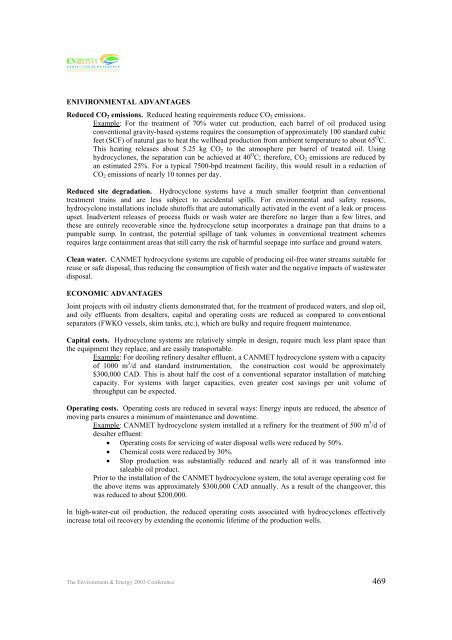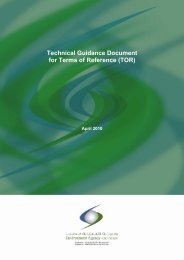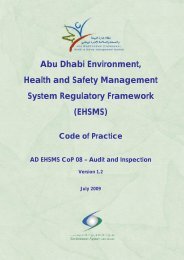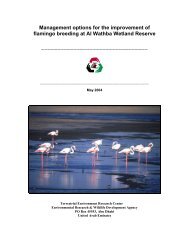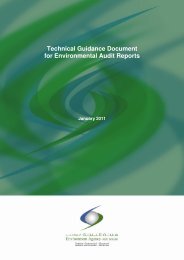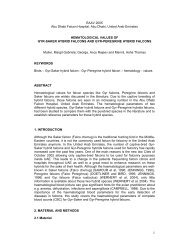The CANMET Hydrocyclone: An Innovative Technology for the ...
The CANMET Hydrocyclone: An Innovative Technology for the ...
The CANMET Hydrocyclone: An Innovative Technology for the ...
- No tags were found...
You also want an ePaper? Increase the reach of your titles
YUMPU automatically turns print PDFs into web optimized ePapers that Google loves.
ENIVIRONMENTAL ADVANTAGESReduced CO 2 emissions. Reduced heating requirements reduce CO 2 emissions.Example: For <strong>the</strong> treatment of 70% water cut production, each barrel of oil produced usingconventional gravity-based systems requires <strong>the</strong> consumption of approximately 100 standard cubicfeet (SCF) of natural gas to heat <strong>the</strong> wellhead production from ambient temperature to about 65 O C.This heating releases about 5.25 kg CO 2 to <strong>the</strong> atmosphere per barrel of treated oil. Usinghydrocyclones, <strong>the</strong> separation can be achieved at 40 O C; <strong>the</strong>re<strong>for</strong>e, CO 2 emissions are reduced byan estimated 25%. For a typical 7500-bpd treatment facility, this would result in a reduction ofCO 2 emissions of nearly 10 tonnes per day.Reduced site degradation. <strong>Hydrocyclone</strong> systems have a much smaller footprint than conventionaltreatment trains and are less subject to accidental spills. For environmental and safety reasons,hydrocyclone installations include shutoffs that are automatically activated in <strong>the</strong> event of a leak or processupset. Inadvertent releases of process fluids or wash water are <strong>the</strong>re<strong>for</strong>e no larger than a few litres, and<strong>the</strong>se are entirely recoverable since <strong>the</strong> hydrocyclone setup incorporates a drainage pan that drains to apumpable sump. In contrast, <strong>the</strong> potential spillage of tank volumes in conventional treatment schemesrequires large containment areas that still carry <strong>the</strong> risk of harmful seepage into surface and ground waters.Clean water. <strong>CANMET</strong> hydrocyclone systems are capable of producing oil-free water streams suitable <strong>for</strong>reuse or safe disposal, thus reducing <strong>the</strong> consumption of fresh water and <strong>the</strong> negative impacts of wastewaterdisposal.ECONOMIC ADVANTAGESJoint projects with oil industry clients demonstrated that, <strong>for</strong> <strong>the</strong> treatment of produced waters, and slop oil,and oily effluents from desalters, capital and operating costs are reduced as compared to conventionalseparators (FWKO vessels, skim tanks, etc.), which are bulky and require frequent maintenance.Capital costs. <strong>Hydrocyclone</strong> systems are relatively simple in design, require much less plant space than<strong>the</strong> equipment <strong>the</strong>y replace, and are easily transportable.Example: For deoiling refinery desalter effluent, a <strong>CANMET</strong> hydrocyclone system with a capacityof 1000 m 3 /d and standard instrumentation, <strong>the</strong> construction cost would be approximately$300,000 CAD. This is about half <strong>the</strong> cost of a conventional separator installation of matchingcapacity. For systems with larger capacities, even greater cost savings per unit volume ofthroughput can be expected.Operating costs. Operating costs are reduced in several ways: Energy inputs are reduced, <strong>the</strong> absence ofmoving parts ensures a minimum of maintenance and downtime.Example: <strong>CANMET</strong> hydrocyclone system installed at a refinery <strong>for</strong> <strong>the</strong> treatment of 500 m 3 /d ofdesalter effluent:• Operating costs <strong>for</strong> servicing of water disposal wells were reduced by 50%.• Chemical costs were reduced by 30%.• Slop production was substantially reduced and nearly all of it was trans<strong>for</strong>med intosaleable oil product.Prior to <strong>the</strong> installation of <strong>the</strong> <strong>CANMET</strong> hydrocyclone system, <strong>the</strong> total average operating cost <strong>for</strong><strong>the</strong> above items was approximately $300,000 CAD annually. As a result of <strong>the</strong> changeover, thiswas reduced to about $200,000.In high-water-cut oil production, <strong>the</strong> reduced operating costs associated with hydrocyclones effectivelyincrease total oil recovery by extending <strong>the</strong> economic lifetime of <strong>the</strong> production wells.<strong>The</strong> Environment & Energy 2003 Conference 469


